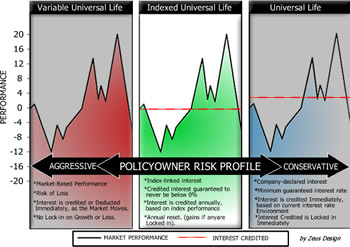What is Equity Indexed Universal Life Insurance?
Equity Indexed Universal Life Insurance
Like traditional universal life insurance, equity indexed universal life (EIUL) offers numerous advantage including flexible premium payments, low cost permanent life insurance, tax deferred growth of cash values with borrowing ability(1), tax free death benefits (2) and the ability to adjust a policy to meet specific personal or business needs.
The major difference with equity indexed universal life is the option to participate indirectly in the upward movement of a stock index without accepting the normal risk associated with investing in the stock market. The actual interest credited to a policy’s cash value is determined by the annual changes of an equities index (excluding dividends). Most insurance companies use the S & P 500 Index® (3) as the underlying index for their equity indexed life product. For more information on equity indices, see “What is an equity index?”
With equity indexed life, in years where the underlying equity index increases, the policy cash value is increased up to a certain limit usually referred to as the growth cap. The cap varies among insurance companies but is currently somewhere around 10-14% annually. In years where the underlying equity index is flat or loses value, the cash value is subject to the growth floor. The floor is generally guaranteed to be 0%. Additionally, some companies offer a cumulative guarantee that assures a minimum effective interest rate over a given time period. This combination of the potential to realize higher upside returns without the downside risk makes the equity indexed life insurance policy a unique and attractive cash accumulation vehicle. For more information, see “How the Equity Indexed Universal Life Insurance Policy Works”.
As the chart below shows, the real value of the equity
indexed universal life policy is its ability to earn
a credited interest rate higher than a traditional
universal life or whole life insurance policy without
accepting the risk of loss associated with
the variable
universal life policy. The equity indexed universal
life policy is designed to capture the best elements
of both the fixed whole life and the variable life
policies enabling it to earn an acceptable “middle
of the road interest rate” without taking on
unnecessary risk.
Please
Click on the picture for a larger view
(1)
Growth on accumulated cash values is generally taxable
only upon withdrawal. Adverse
tax consequences may result if withdrawals exceed premiums
paid into the policy. Policy loans from life insurance
policies generally are not subject to income tax. A
policy withdrawal or loan will reduce the insurance
policy’s ultimate death benefit and cash value.
Additionally, depending on the insurance company, a
surrender charge may apply if the policy cash values
are fully surrendered before the surrender period expires.
Please consult with your attorney or tax advisor
(2) Proceeds from a life insurance policy paid upon
the death of the insured are in most cases excluded
from the beneficiary’s gross income.
(3) The S & P 500 (Standard and Poor’s Composite
Price Index) is composed of 500 commons stocks representing
major U.S. industry sectors.
“
Standard and Poor’s®,” “S & P®,” “S & P
500®,” “Standard & Poor’s
500,” and “500” are trademarks of
The McGraw-Hill Companies, Inc. Equity indexed universal
life insurance is not sponsored, endorsed, sold or
promoted by Standard & Poor’s and Standard & Poor’s
makes no representation regarding the advisability
of purchasing such a policy.







